
In 1971, the first year of my chequered career at university, I bought a
text-book called "Advanced Calculus", by Louis Brand, written in 1955. The
copy I have is the sixth printing, May, 1967.
On a whim, as I write this, I just checked on the net to see if I could find
anything about Louis Brand.
This link
popped up.
My goodness - he was born in 1885, and died in 1971 - the year I bought the
book! If he were still alive now (2005), he would be 120 years old. It's a
funny feeling to know that I've owned something for 34 years that provides
such a link with the past, never having realized it!
Anyway, I digress. The reason for digging the book out was that I remembered
that it contained a poem by another author, quoted just before Chapter 1.
The poem, written by Clarence R. Wylie, Jr., is called "PARADOX". It's in
sonnet form, but blank - that is, with no rhymes. I remember reading
it in "Advanced Calculus" as a young student. I liked the poem, and read it
over several times, trying to figure out exactly what it meant. Eventually,
I understood it.
As Dr. Brand himself says in his preface, it
"expresses so felicitously the essential nature of mathematics"
.
It does indeed. This page has two features of interest: the poem itself; and
the fact that this is almost certainly one of a very small number of
web-pages where you can the find the word
"felicitously"
not once, but
twice. Good value, n'est-ce pas?
Here, then, is the poem. Be inspired, as I was.
PARADOX
Not truth, nor certainty. These I forswore
YET BRIDGES STAND...
In Northern Tasmania, where I live, we have a very remarkable bridge. The
first of its kind anywhere in the world, a cable-stayed truss bridge with a
96m-high sloping A-frame (20 degrees from the vertical), the Batman Bridge
(named after explorer John Batman, not the super-hero!) spans the
Tamar River at Whirlpool Reach near Deviot, about 30km north of Launceston.
The bridge was opened in 1968. In the mid 1960's, as a kid, I was lucky
enough to see it being built. A friend of my parents owned a shack at
Deviot, just a bit south of the bridge on the western side; he had a small
cabin cruiser, and he'd take us out on the river where we could look up and
see the partially-completed structure. I took some B&W pictures with my
little Brownie camera; if I can find them I'll get them scanned and post the
results here.
In the meantime, here are some pictures my son and I took with a borrowed
digital camera around Easter 2005. You can click on them to see bigger
versions; they're all 480 pixels high and between 384 and 640 pixels wide.
We like our bridge. If you come to visit our lovely island state, I think
you will too. It's a good example of how a technological development can
actually enhance the surrounding area, instead of ruining it. (Maybe that's
a paradox in itself...)
Here's a link to the Tasmanian government's website, promoting the state:
www.discovertasmania.com
- and here's a link to another website which presents a contrasting point of
view:
www.discover-tasmania.com
What a difference a dash makes...
UPDATE, NOVEMBER 2005
Life is full of surprises.
Credit should be given where due, and permission must be sought where
applicable. I've spent quite a bit of time finding out when and where
"PARADOX" was first published, and attempting to find out whom to contact
to enquire whether I needed permission to quote the poem here.
I gather that I'm far from the only person who's read and enjoyed "PARADOX",
and felt the desire to share its charms. It's presented in quite a lot of
other websites.
I found that the poem first appeared in the July 1948 edition of
Scientific Monthly (which is no longer published), and has been
quoted in numerous other publications since. Having emailed several people,
the best advice I have is that it's OK to quote items like this ("fair
usage") provided there is no commercial incentive to do so, and one gives
credit to the author. So that's what I've done!
The surprise to which I alluded above is as follows:
Recently, while hunting on the web for information about Dr. Wylie, I saw a
mention of a book he had written entitled "101 Puzzles in Thought and Logic"
(Dover Publications, Inc., 1957). Something clicked into place in my mind.
Several years ago, I bought a number of recreational mathematics books from
a bookshop which was (I seem to recall) having a sale. You've guessed it -
one of them was indeed "101 Puzzles in Thought and Logic", by C.R.Wylie Jr.!
So I dug it out to make sure. Sure enough, it was the right book! It's still
available; click
here
to see the details.
It's a small world, after all!
UPDATE, Tuesday, 14th July 2009
Just for fun, I've today spent a bit of time Googling about Louis Brand and
C.R.Wylie, just to see what turned up. I was delighted to find a discussion
page in which a participant cites Professor Wylie's poem "Paradox" (the same
one referred to above).
It's a somewhat philosophical discussion, which deals with the nature of
"awareness", scientific method, mathematics, and various related issues.
(The poem is cited there in order to illustrate a point.) The reason that
this has caught my attention is that I've very recently posted a
page
on this site dealing with somewhat similar matters, revolving around such
things as zero-point energy (which this website has come to be increasingly
about, in recent times), quantum mechanics, and consciousness.
Here's the URL to the page I just found:
http://www.physicsforums.com/showthread.php?t=106775&page=10
Do have a look, and allow its content to wrap itself around your head (or
vice versa!).
My home page
Preliminaries (Copyright, Safety)
PARADOX

In my novitiate, as young men called
To holy orders must abjure the world.
'If . . . , then . . . ,' this only I assert;
And my successes are but pretty chains
Linking twin doubts, for it is vain to ask
If what I postulate be justified,
Or what I prove possess the stamp of fact.
Yet bridges stand, and men no longer crawl
In two dimensions. And such triumphs stem
In no small measure from the power this game,
Played with the thrice-attenuated shades
Of things, has over their originals.
How frail the wand, but how profound the spell!

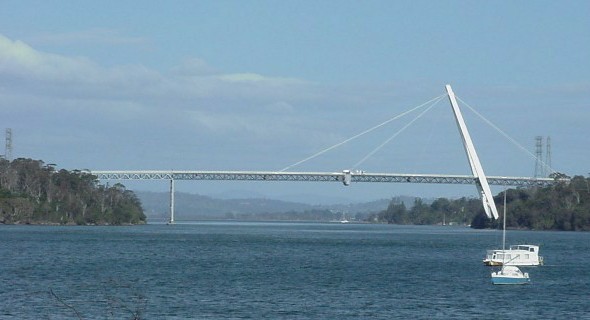
Looking upstream from near Kayena, 1-2km north of the bridge.
Photograph taken Tuesday 2nd October, 2007; posted 3rd October.
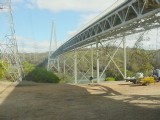
Looking westward toward the A-frame from
the eastern side, just south of the bridge
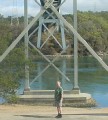
Looking westward from the eastern side, underneath the
bridge. The lower part of the A-frame is clearly visible
across the river. Yours truly looking suitably photogenic
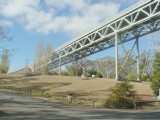
Looking toward the eastern abutment from the visitors'
car park on the eastern side, just north of the bridge

Looking westward toward the A-frame
from the car park. You can just see the
top of our Holden Camira station-wagon
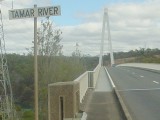
On the bridge, looking toward the
A-frame from the eastern end

Under the bridge, taken looking eastward from near the car park.
Moi again, looking très nonchalant, just to prove I was there
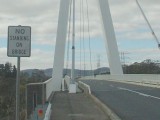
On the bridge, looking eastward from the western end
near the A-frame. You can clearly see one of the thick
supporting cables. (Bring your own chair...?)

On the bridge, looking up into the A-frame. The two
really thick cables anchor the A-frame to the western
abutment; the other four slightly thinner cables take
most of the weight of the bridge. Impressive huh!
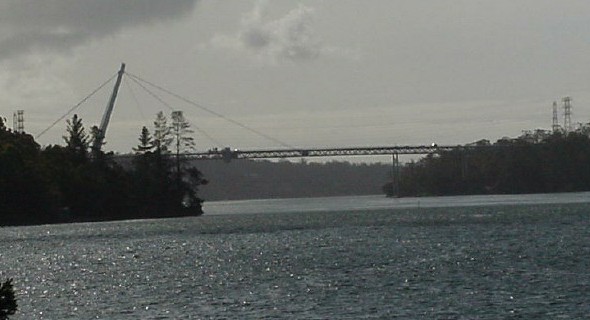
Looking downstream from Deviot, 2-3km south of the bridge.
Photograph taken Tuesday 2nd October, 2007; posted 3rd October.
(Click to see a 480x640 zoom of the A-frame.)




 Return to Mathematical stuff menu
Return to Mathematical stuff menu

